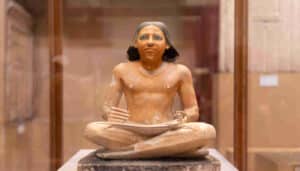One of the great enigmas about Ancient Egypt is to know where the tomb of Nefertiti is. And although it seemed close to being solved, it still remains a mystery. The famous Egyptologist Zahi Hawas asserted in 2022 that the discovery would soon be made official, but soon after he had to rectify it due to problems related to DNA analysis. In the following lines we put the pieces in order to, hopefully, be able to fit them together in the not too distant future and finally discover where Nefertiti’s tomb is.
Who was Nefertiti and how was her burial?
Nefertiti was one of the most famous queens of Ancient Egypt. And not only because her bust, preserved in the Neues Museum in Berlin, is a canon of universal and timeless feminine beauty. It is also because she held a key position in a momentous period: the wife of the ‘pharaoh-heresy’ Akhenaten, also known by other names during his lifetime, as Amenhotep IV or Amenophis IV, who established a failed monotheism and moved the capital to Akhetaton (today, Tell el Amarna).
That marriage, however, does not make her de facto mother of Tutankhamun, son of Akhenaten, as it is believed that he, a few years before his death, had relegated Nefertiti for a secondary wife, although there is no consensus on this and other Egyptologists do support the status of Nefertiti as mother of Tutankhamun. However, little is known of the last years of Nefertiti’s life, hence the mystery of her tomb.
On the other hand, let us remember that Tutankhamun is another of the most recognized pharaohs, thanks to the richness of his tomb, discovered in 1922 by Howard Carter. It was perhaps the desire to coincide between both anniversaries that, a century later, motivated the desire to announce the discovery of the tomb of Nefertiti, which could not materialize.
Main hypotheses about his grave
In fact, the main clues point to the Valley of the Kings. The Royal Tomb of Akhenaten’s family in Akhethaton (Tell el-Amarna) is empty, and it is most likely that his mummies were transferred to the Valley of the Kings, necropolis of Luxor and main burial place of the XVIII Dynasty.
Since the beginning of the 21st century, different hypotheses have been launched, based on conjectures and DNA analysis, but as of today (August 2024), there is no official announcement. The aforementioned Zahi Hawass was almost certain that the mummy of Nefertiti was one of those found in tomb KV21, but the aforementioned technical problems led him to recant.
Another theory put forward, in this case by Egyptologist Nicholas Reeves, indicates that Nefertiti’s tomb would be found in none other than tomb KV62, that is, Tutankhamun’s tomb . How is this possible? Let us remember that Tutankhamun is called the ‘child-king’ for having ruled from the age of 10 and having died prematurely around the age of 19. Therefore, a worthy place had to be hastily sought for his burial and journey to the Beyond, for which a previous tomb would have been reused, in this case that of Nefertiti.
To give credence to this option, and add more mystery and complexity to the matter, there are many Egyptologists who see Nefertiti under the name of Smenkhare or Semenejkara, successor of Akhenaten and precursor of Tutankhamun, a fleeting pharaoh (several years of reign) and of whom hardly anything is known. Did Nefertiti adopt this name to rule as if she were a regent of Tutankhamun?
As you can see, answering the question of where is the tomb of Nefertiti is somewhat complex, and there are even many other variables to take into account. But this only increases the interest in the visit to the Valley of the Kings of Luxor, and imagine with more or less foundation which of these burial chambers was really the one occupied by this famous queen.






